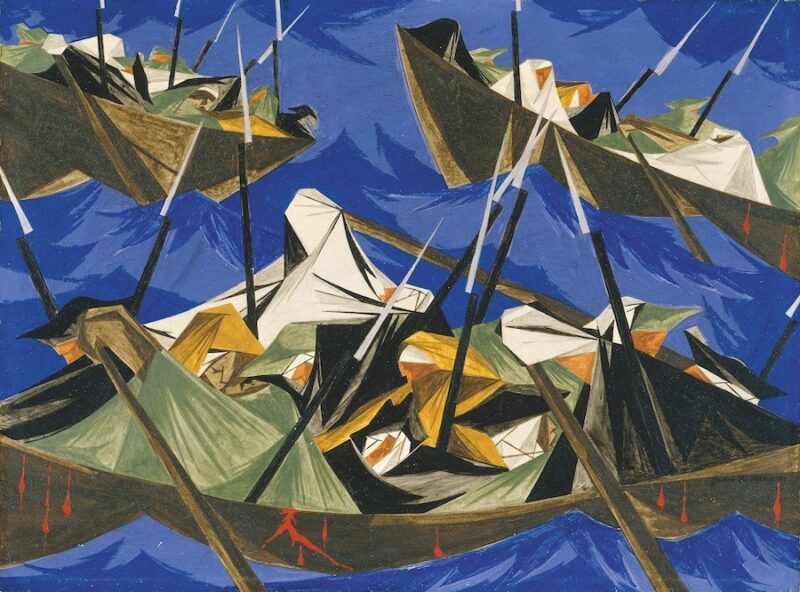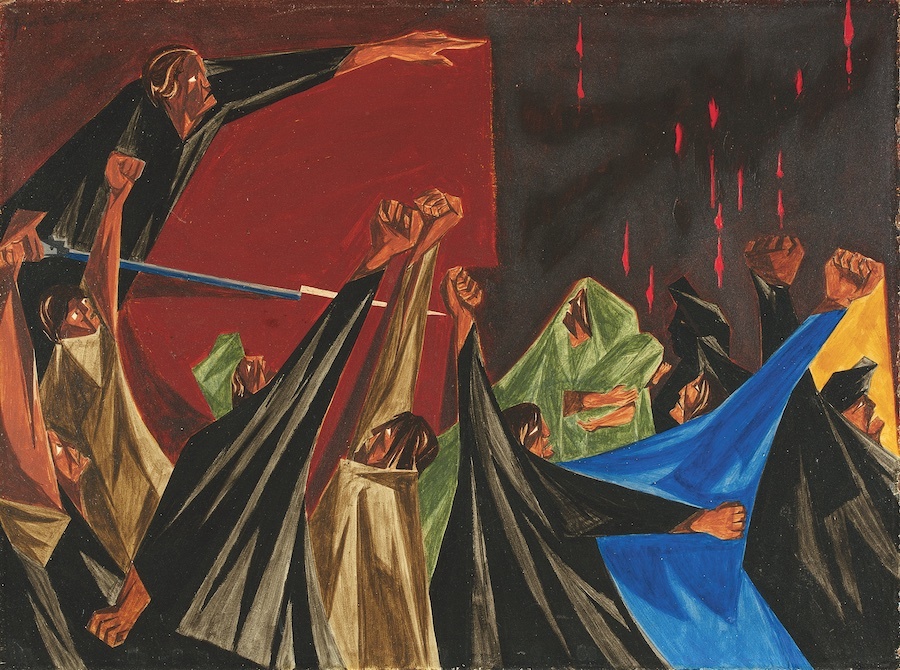Jacob Lawrence’s The American Struggle: Remembering Those History Forgets
Review of The American Struggle, presented by Seattle Art Museum
Written by Teen Writer Yoon Lee and edited by Teen Editor Lucia McLaren

The idea of the American struggle is one often mentioned in discussions around U.S. history—the American Revolution, the War of 1812, the Civil War, and all of the not-so-glamorous areas in between that lend credence to our current status of “world superpower” and therefore our so-called moral superiority. One facet of this struggle is rarely remembered: the effect people of color and women had on the foundation and mettle of the United States. Even with the efforts of historians, new school curriculums and media like Hamilton, this essential part of the American soul is often forgotten.
One lesson in this perception of history can be found not by looking forward, but by looking back. More appropriately, by piecing together the past, which is exactly what the Seattle Art Museum exhibition for Jacob Lawrence’s The American Struggle sought to do.
Jacob Lawrence was an African-American artist who created the 30-piece The American Struggle from 1954 to 1956, using egg tempera on hardboard. His modernist style, use of color, and subtle focus and framing sought to portray the commonly overlooked role of people of color and women in American history, set from the founding of the country to the late 1810s. Unfortunately, his anthology was only fully seen once, in 1958, before the 30 pieces were sold off to a private collector and scattered across the globe. Even now, three are missing—Panel 14 only has a black-and-white photo, Panel 15 has a photo scan, and Panel 16 is completely missing, with only a title remaining. Regardless, the SAM’s current exhibition is the closest Lawrence’s revolutionary series has gotten to reunification in more than 60 years.
The exhibition starts with the context of Lawrence’s series, set in an open area. With a format of painting, explanation, and then painting, the open-area exhibit crawls the walls of the museum. It goes left-to-right and right-to-left, circling the audience around a central 3D exhibit made by a contemporary artist. Each painting evokes revolutionary artwork, with harsh lines and near-uniform colors that draw attention to clear action and dramatized emotions, and an emphasis on hands and fists evocative of early and mid-century Russian and Korean modernism.
Some paintings, such as Panel-Seven (titled “The summer soldier and the sunshine patriot will, in this crisis, shrink from the service of his country.—Thomas Paine, 1776”) are heavily nuanced. At first, it seems like a run-of-the-mill, albeit modernist, painting portraying the harsh cold of the winter of 1776 to 1777, with soldiers in monotone cloaks huddling to conserve warmth. However, Lawrence demonstrates a subtle message: the sole Black soldier is clad in bright yellow, a singular figure huddled over yet containing a stout devotion through his musket held vertically like a flag. This soldier represents one of 9,000 Black men who fought in the Continental Army, making up 4.5 percent of the total Revolutionary force.
Other panels clearly deviate from stereotypical portrayals of the American struggle. Panel 15, titled “We, the people of the United States, in order to form a more perfect Union, establish justice, insure domestic tranquility…—17 September 1787,” coincides with the signing of the US Constitution. Instead of portraying the titular signing, however, Lawrence chooses to emphasize the exhaustion, political struggle, and disorder of the nation’s first days. Thirteen figures argue—the thirteen state representatives that would eventually settle on the contentious “three-fifths compromise,” which effectively labeled enslaved people as three-fifths the electoral worth of one not enslaved.
Lawrence’s The American Struggle follows this format, using his modernist style to emphasize and symbolize the various struggles that underrepresented groups helped the nation face.

SAM’s exhibition does not end with the paintings, however. There are the aforementioned 3D features, one of which displays Lawrence’s couch, various photos of his life printed onto the wall, floor, and the ladder, along with his record player. There are two pieces portraying the invisible nature of people of color in the U.S.: normally you can only see a small, huddled group, and holding a flashlight to the painting reveals large contingent crowds as well.
Finally, there is the 31st Panel, or panels, more accurately. For the first time, youth art pieces are being displayed in the SAM next to professional artists, each of which responds to the following question: “What would the 31st Panel of The American Struggle be?” It is quite interesting to see the diversity of topics covered: the Black Lives Matter movement; the invisibility of Black soldiers during the Civil War; transgender rights; the struggle against COVID-19; the unfortunately relevant panel regarding anti-Asian racism. Their portrayals and art styles vary as well. Some are extremely clean and modern, others are strikingly anarchic. Some parallel Lawrence’s modernist style near-perfectly, others more accurately resemble contemporary digital art styles. Some use muted, secondary colors, others use bright primaries. These arrestingly unique panels demonstrate this generation’s view on the new “American Struggle.”
While the remaining three panels are lost, Jacob Lawrence’s The American Struggle cannot truly be complete. However, the ideas he imbued in his work are forever relevant, and SAM’s exhibition of student works alongside his perhaps best demonstrates this importance.
Jacob Lawrence's The American Struggle is available at the SAM in person from March 5 to May 23, 2021. For more information see here.
Lead photo credit: Panel 10, 1954, Jacob Lawrence, from Struggle: From the History of the American People.
The TeenTix Newsroom is a group of teen writers led by the Teen Editorial Staff. For each review, Newsroom writers work individually with a teen editor to polish their writing for publication. The Teen Editorial Staff is made up of 6 teens who curate the review portion of the TeenTix blog. More information about the Teen Editorial Staff can be found HERE.
The TeenTix Press Corps promotes critical thinking, communication, and information literacy through criticism and journalism practice for teens. For more information about the Press Corps program see HERE.


